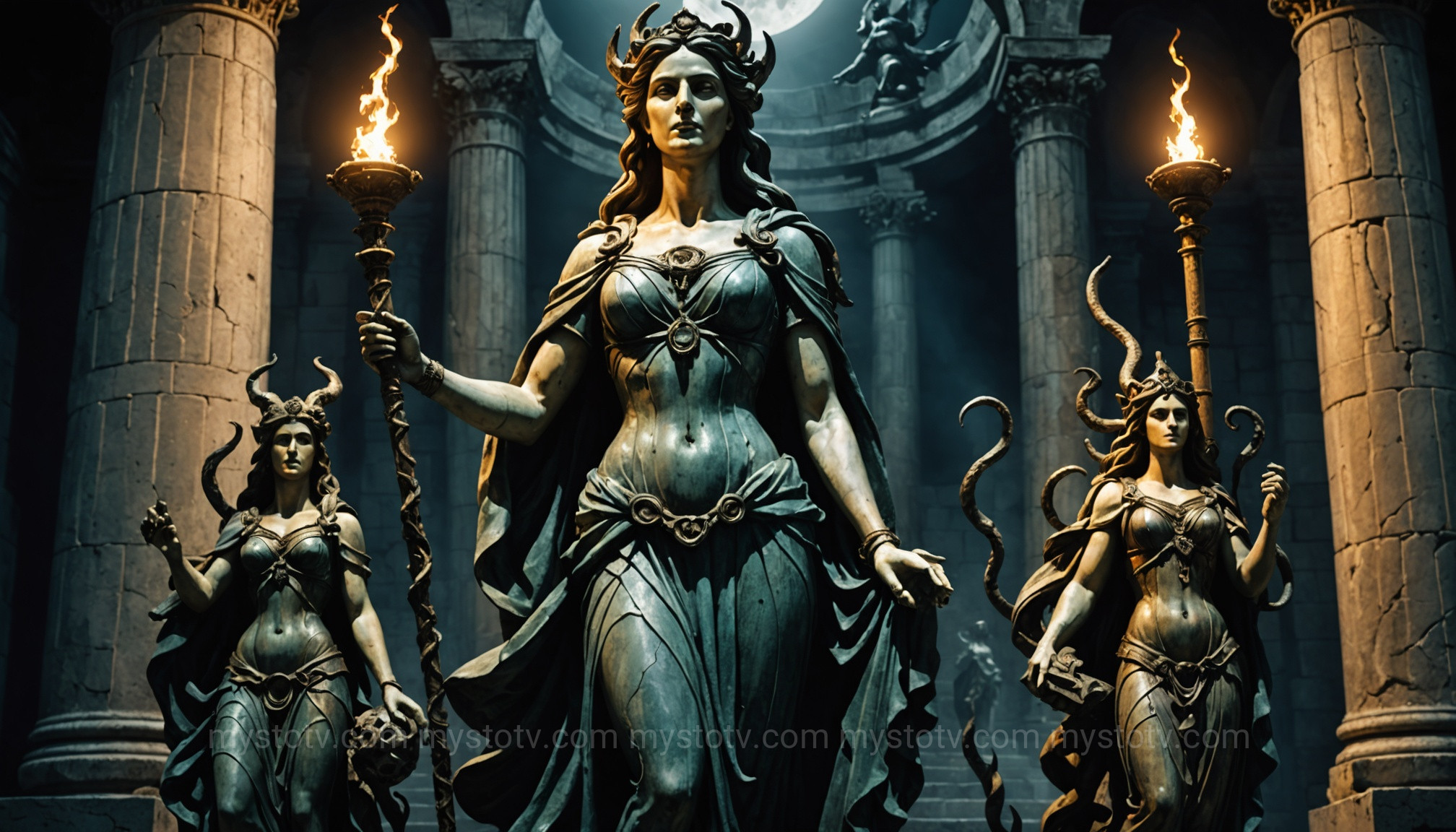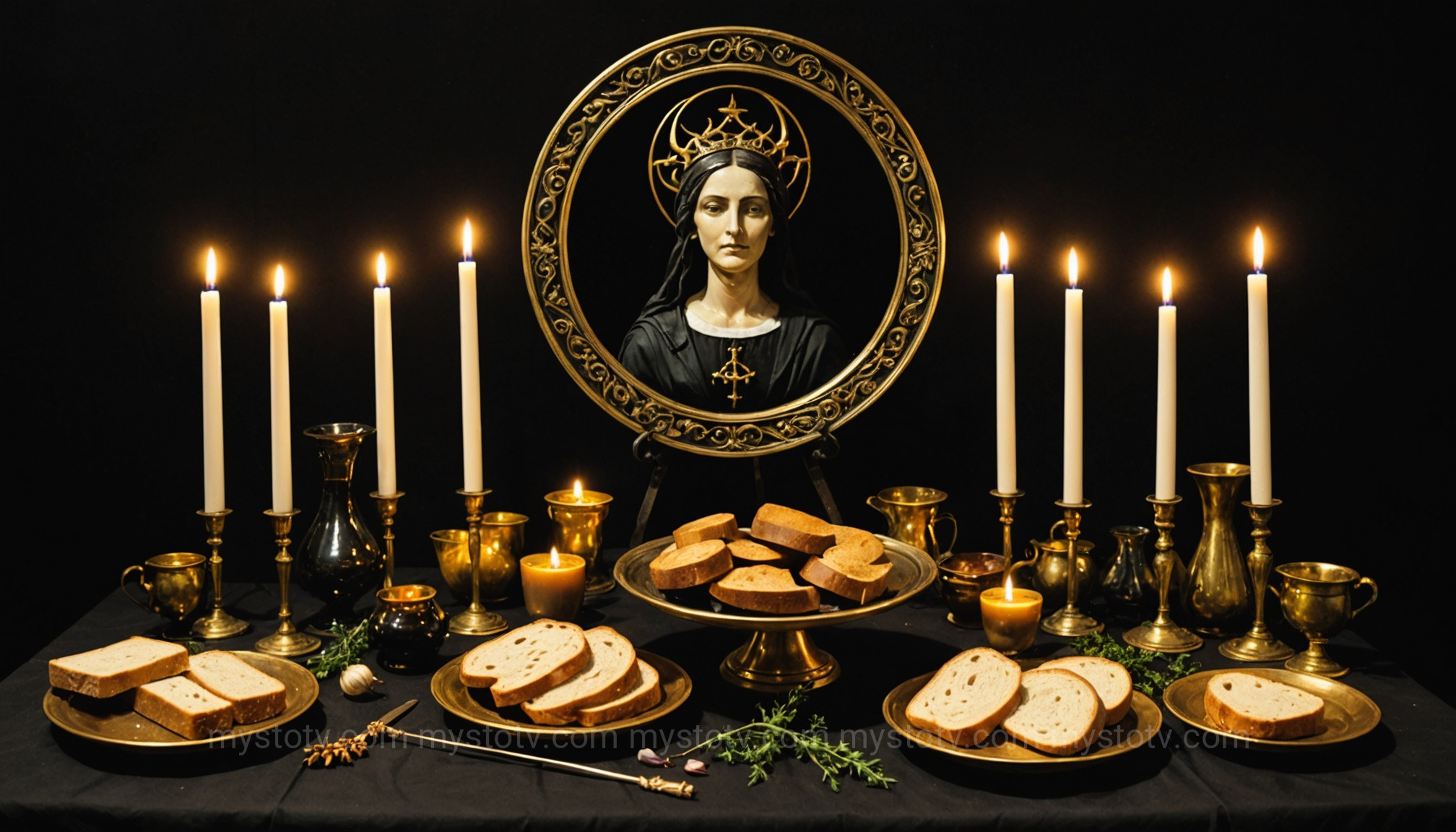My first true encounter with Hecate wasn't in a dusty grimoire or a formal ritual. It was on a quiet, late-night walk, standing at a deserted three-way crossroads under a sliver of a moon. There was no grand invocation, just a profound and sudden awareness of a powerful presence—a guardian of the thresholds between worlds, between choices. It was this visceral feeling of being seen and understood in a moment of uncertainty that drew me to the Hecate goddess of witchcraft. She wasn't an abstract myth, but a living, breathing guide for those of us who navigate life's liminal spaces. This guide is born from that experience, blending ancient history with the tangible, practical connection many of us seek with the Queen of the Crossroads.
Contents
- 1 Who is Hecate? Unveiling the Ancient Hecate Goddess of Witchcraft
- 2 Symbols and Domains of the Hecate Goddess of Witchcraft
- 3 Hecate's Role as a Liminal Deity: The Hecate Goddess of Witchcraft at the Thresholds
- 4 Connecting with the Hecate Goddess of Witchcraft in Modern Practice
- 5 Frequently Asked Questions about the Hecate Goddess of Witchcraft
- 6 References
- 7 Conclusion: Embracing the Guide at the Crossroads
Who is Hecate? Unveiling the Ancient Hecate Goddess of Witchcraft

To truly understand the Hecate goddess of witchcraft, we must look beyond her modern associations and journey back to her complex origins. Hecate (or Hekate) was not originally a Greek goddess. Most scholars trace her roots to the Carians of Anatolia (modern-day Turkey), where she was a great mother goddess, a ruler of the earth, sea, and sky. When she was incorporated into the Greek pantheon, Hesiod’s Theogony (c. 700 BCE) describes her as a Titan who Zeus honored above all others, retaining her dominion over these three realms.
Initially, she was seen as a benevolent figure, a bestower of wealth, wisdom, and victory to mortals. She was a protector of the household and a guardian of entrances. It was only later, particularly in Athenian culture, that her character shifted. Her connection to the night, the moon, and the spirit world linked her more explicitly with magic, ghosts, and sorcery. This evolution, from a universal goddess to the powerful matron of witches, is not a contradiction but a testament to her immense and multifaceted nature. She is not simply "dark" or "light"; she encompasses the full spectrum of existence, embodying the shadows necessary for illumination.
This historical journey is crucial for any modern practitioner. Recognizing her ancient, all-encompassing power provides a richer context than simply viewing her through the narrow lens of magic. She is a goddess of transformation, and her own story is one of profound change, reflecting the very journeys she guides her followers on today.
Symbols and Domains of the Hecate Goddess of Witchcraft
Hecate’s power is often understood through her potent symbols and the domains she governs. These are not mere decorations but are keys, quite literally, to unlocking her mysteries. For those who work with the Hecate goddess of witchcraft, understanding these symbols is the first step toward building a meaningful relationship. They are the language she uses to communicate her presence and guidance.
The Crossroads: A Place of Power and Choice

The crossroads, particularly where three roads meet, is Hecate's most iconic domain. In ancient times, shrines to her were placed at intersections and city gates. This space represents more than just a physical location; it is a liminal point of transition, decision, and potential. It is where paths diverge, where the future is unwritten, and where the veil between worlds is thin. When we stand at a crossroads in our own lives—facing a major decision, a career change, or a spiritual turning point—we are in Hecate's territory. Honoring her here is an acknowledgment of her power to guide us through uncertainty and illuminate the path forward.
The Keys and Torches: Illumination and Access
Hecate is frequently depicted holding a pair of torches and a key. The torches are symbols of spiritual illumination. She is Hecate Phosphorus, the light-bringer, who guides us through the darkness of our subconscious, the underworld of our psyche, and the literal night. Her light does not eliminate the shadows but allows us to see what is hidden within them, fostering wisdom and self-awareness. The key represents her authority to unlock any door, whether it be to esoteric knowledge, the gates of the underworld, or the pathways of the human mind. For practitioners, invoking Hecate with her key and torches is a request for access to hidden truths and the light of understanding needed to navigate them.
Her Sacred Animals: Messengers of the Liminal
Hecate is famously accompanied by black dogs. These dogs were often heard howling in the night, heralding her approach. As creatures that roam between the wilderness and civilization, between night and day, they are fitting companions for a liminal goddess. They are her watchers and messengers, often associated with the souls of the dead. Snakes are also sacred to her, representing rebirth, transformation, and chthonic (underworld) knowledge, due to their ability to shed their skin and their connection to the earth. These animals are not pets but extensions of her energy, embodying the wild, untamed, and transformative aspects of the Hecate goddess of witchcraft.
Hecate's Role as a Liminal Deity: The Hecate Goddess of Witchcraft at the Thresholds
Perhaps the most profound aspect of Hecate is her role as a liminal deity—a goddess of the in-between. She is not confined to one realm but exists at the boundaries: between life and death, night and day, civilization and the wild, the conscious and the unconscious. This is why she is revered as the Queen of the Crossroads. This analysis of her liminality is essential for understanding why she is such a powerful figure for modern witches and spiritual seekers.
As a psychopomp, a guide of souls, she walks freely between the world of the living and the realm of the dead. This is not a morbid fascination but a deep understanding of life's greatest transition. For her followers, this means she can be a powerful ally in shadow work—the process of confronting our hidden fears, traumas, and repressed selves. She provides the torch to venture into these personal underworlds and the key to unlock our own healing and integration. When you work with Hecate, you are working with a goddess who understands that true growth happens at the edges of your comfort zone. To learn more about how to apply these concepts, you can explore the guide to connecting with Hecate in modern practice.
Connecting with the Hecate Goddess of Witchcraft in Modern Practice

Building a relationship with the Hecate goddess of witchcraft is a deeply personal journey. It moves beyond academic study into active, devotional practice. Here are practical ways to begin honoring her and inviting her guidance into your life.
Setting Up a Hecate Altar
Your altar is a physical focal point for your devotion. It can be simple or elaborate. Key elements to consider include:
- Colors: Black, silver, red, and gold.
- Symbols: Keys, images of torches, a depiction of a three-way crossroads, a wheel or labyrinth (Strophalos of Hekate).
- Statuary: An image or statue of Hecate in any of her forms.
- Natural Items: Herbs like mugwort, belladonna (with extreme caution), dandelion, and yew; stones like obsidian, smoky quartz, and moonstone.
- Candles: Two candles to represent her torches, often black or white.
Place your altar in a respectful space, ideally near an entryway or a window facing a crossroads if possible, to honor her role as a guardian of thresholds.
Offerings and Devotional Acts
Offerings are a traditional way to show respect and build reciprocity. Hecate is known to appreciate:
- Traditional Foods: Garlic, honey, eggs, dark bread, and fish. "Hecate's Supper" was historically left at a crossroads on the dark moon.
- Libations: Red wine, mead, or dark water (water infused with herbs or colored with food-safe dye).
- Acts of Service: Honoring her is not just about leaving items on an altar. Cleaning up a local crossroads, volunteering at an animal shelter (especially for dogs), guiding someone through a difficult time, or standing up for the marginalized are all powerful devotional acts in her name.
The best time to make offerings is often considered the dark moon, the time of deep introspection and magic that is her special domain.
Invoking Hecate in Spellwork
The Hecate goddess of witchcraft can be called upon for various magical workings. Her energy is potent for rituals involving protection, divination, banishing negative influences, and rites of transformation. When you invoke her, be clear and respectful. State your intention, explain why you seek her aid, and make an offering. Remember that working with Hecate is a partnership. She is a guide, not a servant. Approach her with humility, reverence, and a willingness to do the necessary personal work she may ask of you in return.
Frequently Asked Questions about the Hecate Goddess of Witchcraft
Navigating a relationship with a deity as complex as Hecate often brings up specific questions. Here are answers to some of the most common ones.
Is Hecate an "evil" or "dark" goddess?
No. This is a common misconception rooted in later patriarchal interpretations that feared powerful female deities connected to magic and the night. Hecate is a chthonic (underworld) and liminal goddess, meaning she governs realms that can be uncomfortable or frightening to humans, such as death, darkness, and the unknown. However, she is a guide through these realms, not a malevolent force within them. Her "darkness" is that of the fertile earth, the womb, and the night sky—full of potential and mystery, not evil.
What are some simple, safe offerings for Hecate?
If you're a beginner or concerned about safety (e.g., leaving food outdoors that could harm wildlife), stick to simple, heartfelt offerings. Garlic is a classic and potent offering. A small dish of honey or a piece of dark bread is also traditional. You can pour a libation of water or wine directly onto the earth at a crossroads. Non-physical offerings are also powerful: dedicate a walk in her honor, spend time in quiet meditation at dusk, or write a poem for her. The intention is more important than the object.
Do I need to be a witch to work with or honor Hecate?
Absolutely not. While she is famously known as the Hecate goddess of witchcraft, her domains are universal. Anyone who stands at a crossroads in life, who seeks guidance through a difficult transition, who wishes to understand their own inner shadows, or who feels a connection to the mysteries of the night can honor her. She is a guardian and guide for all who approach her with respect, regardless of their specific spiritual path or title.
References
- Hesiod. Theogony. c. 700 BCE.
- "Hecate." Theoi Project, www.theoi.com/Khthonios/Hekate.html. Accessed 2023.
- Von Rudloff, R. (1999). Hekate in Ancient Greek Religion. Horned Owl Publishing.
Conclusion: Embracing the Guide at the Crossroads
The journey to understand the Hecate goddess of witchcraft is a journey into the heart of magic, transformation, and self-discovery. She is far more than a simple deity of spells and potions; she is the eternal guardian of the crossroads, the torch-bearer in the dark, and the keeper of the keys to life's deepest mysteries. Whether you are a seasoned witch or a curious soul standing at a personal crossroads, Hecate offers her wisdom and light. By understanding her history, embracing her symbols, and approaching her with respect, you invite a powerful and compassionate guide into your life—one who will not shield you from the darkness, but will illuminate your path through it, ensuring you never have to walk it alone.